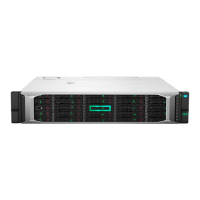RAID level Data redundancy RAID method
RAID 5 Medium Striping and parity
RAID 6 High Striping and parity
RAID 6 with Advance Data Guarding
(ADG)
High Striping and parity
RAID best practices
• RAID 0: Do not use LUNs if fault tolerance is required. Consider RAID 0 only for noncritical storage. RAID 0 LUNs
provide the best performance for applications that use random I/O.
• RAID 1: In general, RAID1 virtual disks provide better performance characteristics over a wider range of application
workloads than RAID 5.
• RAID 5: RAID 50 tolerates one drive failure in each spanned array without loss of data. RAID 50 requires less rebuild
time than single RAID 5 arrays RAID 50 requires a minimum of six drives.
• RAID 6: RAID 6 is most useful when data loss is unacceptable but cost is also an important factor. The probability that
data loss will occur when an array is configured with RAID 6 is less than it would be if it was configured with RAID 5.
However, write performance is lower than RAID 5 because of the two sets of parity data.
• RAID 6 with Advance Data Guarding (ADG): Organizations implementing a large drive array should consider RAID 6
because it can tolerate up to two simultaneous drive failures without downtime or data loss.
Disk drive sizes and types
RAID arrays should be composed of disk drives of the same size and performance capability. When drives are mixed within
a disk enclosure, the usable capacity and the processing ability of the entire storage subsystem is aected.
For example, when a RAID array is composed of dierent-sized drives, the RAID array defaults to the smallest individual
drive size, and capacity in the larger drives goes unused.
Spare disks
Spares are disks that are not active members of any particular array, but have been configured to be used when a disk in
one of the arrays fails. If a spare is present, it will immediately be used to begin rebuilding the information that was on the
failed disk, using parity information from the other member disks. During the rebuilding process, the array is operating in a
reduced state and, unless it is a RAID 6 or RAID 1+0 array, it cannot tolerate another disk failure in the same array. If
another disk fails at this time, the array becomes inaccessible and information stored there must be restored from backup.
After the rebuild of the data onto the spare is completed, when a replacement drive is inserted to replace the failed drive,
the system will automatically transfer the data from the spare onto the replacement drive and return the spare to an
available-spare state. It is important to note that the process of rebuilding the spare or the replacement drive must not be
interrupted or the process will be aborted. Some administrators have multiple spare disks, so that multiple arrays can
experience failure and successfully recover, before administrative intervention would be required to replace the spare or
failed disk. When assigning a spare to an array, the administrator chooses which arrays and how many arrays are
protected by that spare.
Array sizing
As a general rule, the greater the number of drives that are included in an array, the greater the performance level that
can be achieved. However, performance considerations are oset by fault tolerance considerations. The greater the
number of drives in an array, the higher the probability of one or more disk failures in that array. The administrator must
strike a balance between performance and fault tolerance.
Preparing
9

